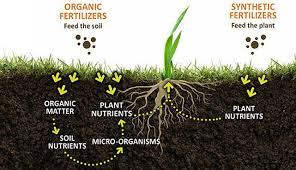
Fertilizers
FERTILIZERS
Fertilizers are water soluble substances, which are applied to the soil to increase the supply of one or more of the essential nutrients such as nitrogen, phosphorus or potash essential for the nourishment of plants. Agriculture is the oldest industry. Man had been using different methods to enhance agriculture production. In 5000 BC Chinese used animal manure as fertilizer to increase crop yield. Plants need certain elements for their growth during different stages of development. These elements are called plant nutrients. Fertilizers are generally inorganic materials and contain these elements in the form of soluble chemical compounds which are essential for the growth and development of crops. Plant nutrients are of two types i.e.
Micronutrients: Those nutrients which are required in very small amounts (6 gm to 200 gm per acre) are called micronutrients. e.g., Boron, Copper, Chlorine, Iron, Molybdenum, Zinc etc.
Macronutrients: Those nutrients which are required in large amounts (5 Kg to 200 Kg per acre) are called macronutrients. E.g., Carbon, Calcium, Hydrogen, Magnesium, Nitrogen, Oxygen, Potassium, Phosphorous, Sulphur etc.
Functions of Fertilizers:
- It helps the soil to make up the deficiency of nutrient element and becomes fertile again.
- Supply of necessary food.
- Maintain PH of soil in between 7.00 to 8.00. It should be noted down that the soil having PH below 3 or above 10 is sterile.
Properties of a good Fertilizer:
Types of Fertilizers:
Fertilizers have been classified into the following types.
1. Natural Fertilizers
2. Artificial Fertilizers
Natural Fertilizers (Organic Fertilizers):
Organic Fertilizers are the most convenient forms of fertilizers. They are safe and easily available. Things like manure, slurry, worm castings, peat moss, seaweed, sewage and guano are good examples of organic fertilizers. Vegetation material called mulch, such as hay, peat moss, leaves, grass, bark, wood chips, seed hulls, and corn husks all help to aerate the soil, insulate the ground against temperature change, and add needed nutrients. Apart from these naturally occurring minerals like sulfate of potash, limestone and rock phosphate are also considered very good organic fertilizers.
Artificial Fertilizers (Synthetic Fertilizers)
Artificial Fertilizers are also known as synthetic fertilizers and mineral fertilizers. They are obtained from raw mineral materialssuch as ammonium nitrate, ammonium phosphates and potassium chloride. Chilean sodium nitrate, mined rock phosphate and limestone
Artificial fertilizers have been further classified are examples of Inorganic Fertilizers.
Chemical fertilizers may be classified into the following types:
Nitrogenous Fertilizer
In these fertilizers, nitrogen is present as the essential element. Nitrogen forms part of proteins, hormones, chlorophyll, vitamins, and enzymes, and promote stem and leaf growth. Too much nitrogen can delay fruiting, while a deficiency of it can reduce yields and induce yellowing of leaves and stunted growth. Nitrogen fertilizers are applied in organic and/or inorganic forms. Organic nitrogen fertilizers are farmyard manure, guano (excreta and remains of seabirds), dried blood, hoof, and horn. However, organic nitrogen sources must undergo microbial processes that produce nitrate nitrogen. e.g. Ammonium Nitrate NH4NO3, Ammonium Sulphate (NH4)2SO4, Urea etc.
Potassic Fertilizer
In these fertilizers, Potassium is present as the essential element. Potassium contributes to the formation of sugars, carbohydrates, proteins and to cell division; adjusts water balance; enhances the flavor, color, and oil content of fruits; and is very important for leafy crops. Potassium deficiency produces a spotted, curled, or burned appearance to leaves and lowers crop yields. Potassium fertilizers are applied in the following forms: potassium chloride, potassium sulfate, potassium nitrate (Chilli Salt Peter), and wood ash.
Phosphatic Fertilizer
In these fertilizers, phosphate is present as the essential element. Phosphorus plays an important role in seed germination, photosynthesis, protein formation, overall growth and metabolism, and flower and fruit formation. Phosphorus deficiency induces purple stems and leaves, poor flowering and fruiting. Low soil pH (<4) ties up phosphates by favoring the formation of insoluble aluminum and iron phosphates. Phosphorus fertilizers come from different sources: bones, rock phosphate, superphosphate (a mixture of calcium dihydrogen phosphate and calcium sulfate), nitrophosphate, ammonium phosphate, basic slag (by-product in steel manufacture), etc. Phosphatic fertilizers are further classified into:
i. Super Phosphate
The raw material of super phosphate fertilizer is phosphorite. The molecular formula of Phosphorite is [Ca3(PO4)2]3 CaF2. This rock reacts with sulphuric acid and converts into water soluble super phosphate. Ca3(PO4)2 + 2H2SO4 —-> Ca(H2PO4)2 + 2CaSO4
The mixture of calsium dihydrogen phosphate and gypsum is called super phosphate.
ii. Triple Phosphate
This phosphate fertilizer is obtained by the decomposition of phosphate rock or phosphorite with phosphoric acid. Ca3(PO4)2 + 4 H3PO4 —-> 3Ca(H2PO4)2
Fertilizers are also classified according to their mode of operation in soil.
Direct Fertilizers are directly assimilated by plants. For example super phosphate, nitrates and ammonium compounds.
Indirect Fertilizers are the substances which are introduced into the oil to improve its mechanical, chemical or biological properties. Ground dolomite and limestone are used to reduce the acidity of soil and gypsum is used to improve the properties of soils with high conc. of salts.
Complete Fertilizers contain the main ingredients for the growth of plants in the combined form so that additional fertilizer is not required. For example Guano,
Incomplete Fertilizers contain only one or two elements required for the growth of plants. Urea, KNO3
Mixed Fertilizers contain several ingredients and are obtained by mechanical mixing of various fertilizers.


